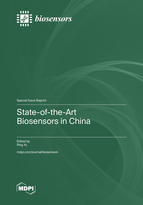State-of-the-Art Biosensors in China
A special issue of Biosensors (ISSN 2079-6374).
Deadline for manuscript submissions: closed (15 December 2022) | Viewed by 10573
Special Issue Editor
Special Issue Information
Dear Colleagues,
We plan to publish a Special Issue entitled “State-of-the-Art Biosensors in China”, this regional project aiming to collect high-quality research articles, comprehensive reviews, and communications regarding all aspects of biosensors and biosensing from China. Our aim is to encourage scientists to publish their experimental and theoretical results in as much detail as possible, including, but not limited to, the following topic themes:
- DNA/RNA chips;
- DNA/RNA sensors;
- Enzyme‐based sensors;
- Lab-on-a-chip technology;
- Micro/nanofluidic devices;
- Immunosensors;
- Biomaterials;
- Real-time and in situ assay based on biosensors technology;
- Label-free biosensors;
- In vivo and in vitro analysis;
- Electroanalysis;
- Bioelectrochemistry;
- Nanopore sensors.
Prof. Dr. Ping Yu
Guest Editor
Manuscript Submission Information
Manuscripts should be submitted online at www.mdpi.com by registering and logging in to this website. Once you are registered, click here to go to the submission form. Manuscripts can be submitted until the deadline. All submissions that pass pre-check are peer-reviewed. Accepted papers will be published continuously in the journal (as soon as accepted) and will be listed together on the special issue website. Research articles, review articles as well as short communications are invited. For planned papers, a title and short abstract (about 100 words) can be sent to the Editorial Office for announcement on this website.
Submitted manuscripts should not have been published previously, nor be under consideration for publication elsewhere (except conference proceedings papers). All manuscripts are thoroughly refereed through a single-blind peer-review process. A guide for authors and other relevant information for submission of manuscripts is available on the Instructions for Authors page. Biosensors is an international peer-reviewed open access monthly journal published by MDPI.
Please visit the Instructions for Authors page before submitting a manuscript. The Article Processing Charge (APC) for publication in this open access journal is 2700 CHF (Swiss Francs). Submitted papers should be well formatted and use good English. Authors may use MDPI's English editing service prior to publication or during author revisions.







